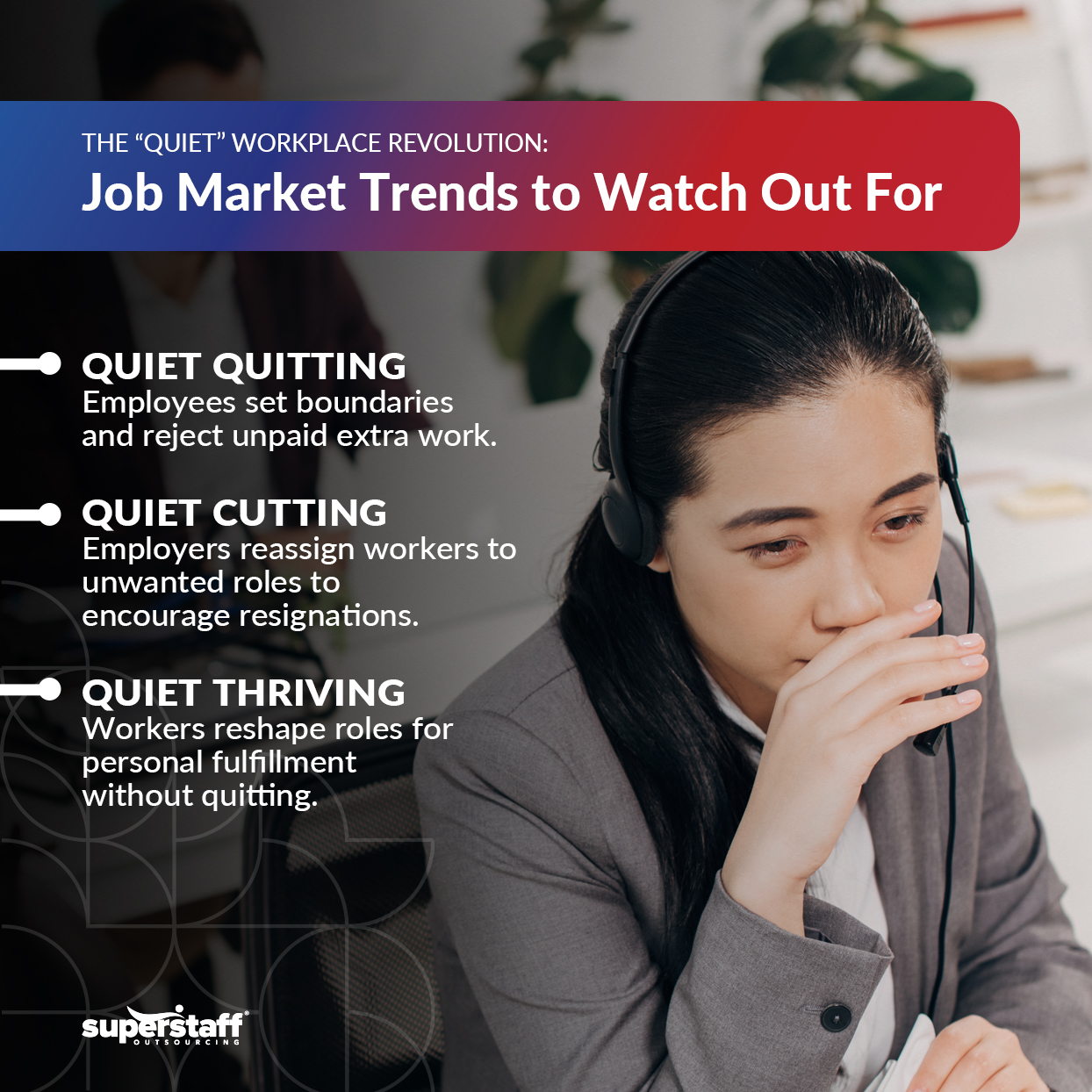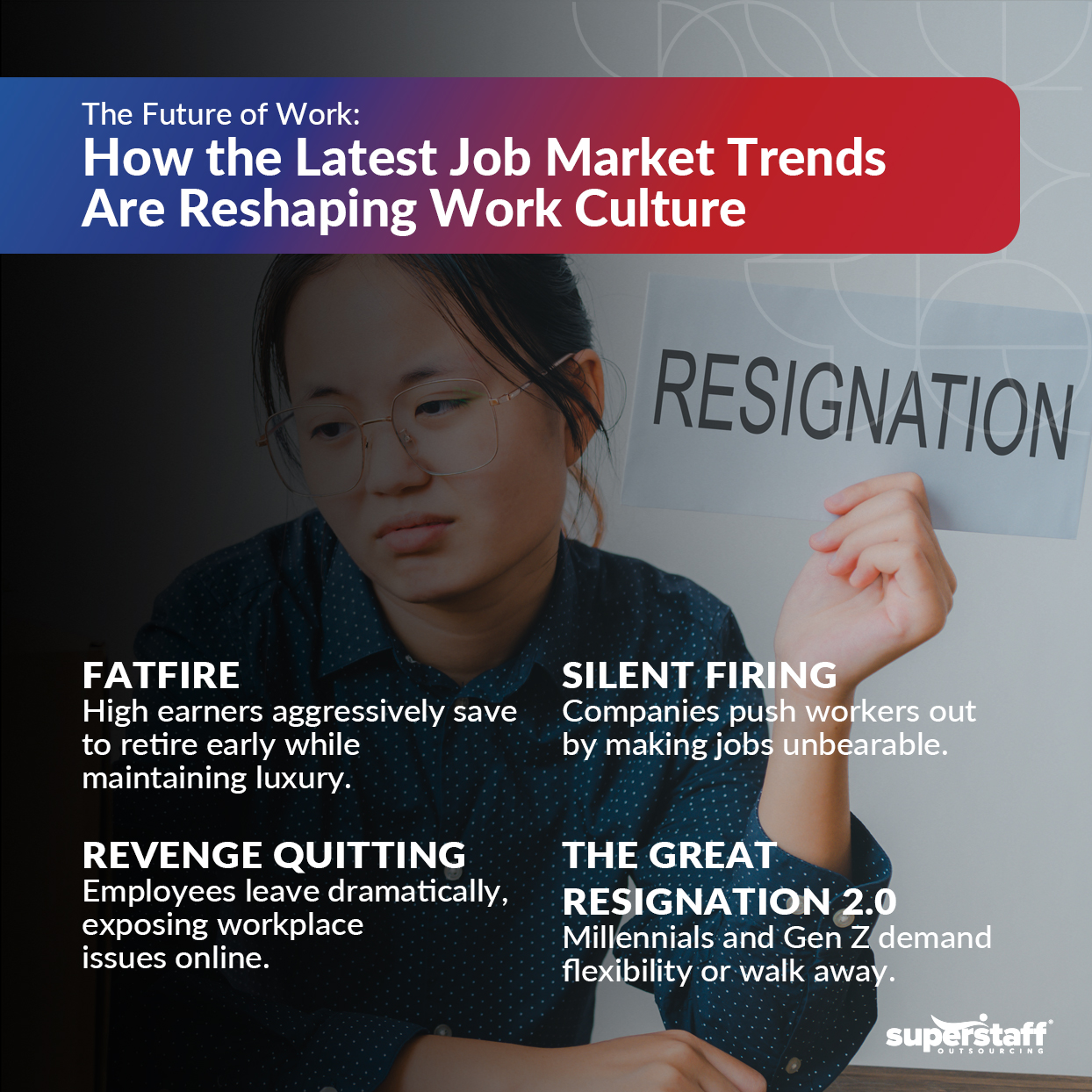
Imagine a workplace where the ultimate career goal isn’t climbing the corporate ladder—but securing financial freedom decades ahead of schedule. Or where job satisfaction isn’t about a flashy promotion but about quietly reshaping your role to better align with your values.
Job market trends 2025 are rapidly evolving, shaped by a workforce that prioritizes autonomy, balance, and well-being over traditional career milestones. Buzzwords like FatFIRE (financial independence and early retirement with a high standard of living), Quiet Thriving (finding fulfillment within an existing role), and Revenge Quitting (leaving a job as an act of reclaiming control) are no longer niche concepts. They’re driving real change in how employees and employers approach work.
This blog unpacks the biggest job market trends of 2025, explaining what they mean, why they matter, and how they’re shaping the future of work. Whether you’re an employee looking to future-proof your career or a business leader adapting to shifting workforce expectations, understanding these trends is key to staying ahead.
Job Market Trends 2025: What Are the Latest Buzzwords You Should Keep an Eye on?
Shifting priorities will define the job market trends of 2025 as employees seek greater financial independence, work-life balance, and personal fulfillment. From FatFIRE and Quiet Thriving to Revenge Quitting, these buzzwords reflect the changing workforce mindset and the strategies companies must adopt to stay competitive.

Quiet Quitting
Quiet Quitting isn’t about leaving a job—it’s about redefining how much effort employees are willing to put in beyond their job descriptions. This trend emerged as a response to burnout, with workers resisting the expectation to take on extra responsibilities without additional compensation. Instead of working late hours, answering emails on weekends, or volunteering for extra projects, employees are focusing strictly on their assigned tasks, preserving their mental well-being in the process.
The rise of Quiet Quitting signals a broader shift in workplace culture. Employees are prioritizing work-life balance and pushing back against hustle culture, recognizing that long-term career success doesn’t have to come at the expense of their personal lives.
However, this shift poses a challenge for employers—maintaining productivity and engagement when workers are no longer willing to go above and beyond. Companies are now faced with the task of redefining incentives, improving workplace conditions, and fostering a culture where engagement comes from fulfillment rather than overwork.
Quiet Cutting
As workers embrace Quiet Quitting, companies are responding with Quiet Cutting—reassigning employees to less desirable roles to cut costs without layoffs. While this avoids severance expenses, it raises ethical concerns about transparency and trust.
A Forbes study found that 1 in 3 employees have experienced Quiet Cutting, with nearly 50% knowing someone affected. Among those impacted, half feel betrayed. While it helps businesses restructure, it can damage morale and loyalty, leading to higher turnover. To avoid disengagement, companies must balance cost-saving moves with clear communication and employee support.
Quiet Thriving
As an alternative to disengagement, Quiet Thriving empowers employees to reshape their roles to foster fulfillment and growth. Instead of withdrawing from extra responsibilities like in Quiet Quitting, workers proactively enhance their job satisfaction by customizing their daily tasks, seeking skill development, and finding meaning in their work. This shift allows employees to regain control over their careers without needing a promotion or job change.
The impact of Quiet Thriving extends beyond individual well-being—it strengthens workplace culture by promoting resilience, creativity, and engagement. Employees who feel they can tailor their roles to their strengths are more motivated and less likely to seek external opportunities, leading to reduced turnover. As companies recognize this trend, they increasingly invest in professional development, mentorship, and role flexibility to encourage employees to thrive rather than just survive.

FatFIRE
For some, thriving quietly isn’t enough; their goal is early financial freedom. FatFIRE redefines career goals by focusing on retiring early with a comfortable lifestyle, not just cutting costs. Unlike lean FIRE, which emphasizes frugality, FatFIRE lets you enjoy life while saving aggressively through high-income careers.
It’s about continuing to work smart and live well, with many professionals shifting to entrepreneurship or consulting to fast-track their wealth. This trend is reshaping career paths, prioritizing financial freedom over traditional career progression.
Revenge Quitting
Yet, not all career decisions are strategic—some arise from frustration and anger. One of the most controversial job trends of 2025, Revenge Quitting isn’t just resigning—it’s making a statement. Frustrated employees call out toxic workplaces, often going viral on social media, damaging employer reputations.
This trend can damage an employer’s reputation, making it harder to attract and retain talent. Public resignations expose workplace issues, forcing companies to rethink their culture and leadership practices. In the long run, businesses that ignore employee concerns risk not just turnover but a broken employer brand that lingers far beyond any single resignation.
Silent Firing
In response to Revenge Quitting, some companies employ their own covert tactics. Enter Silent Firing–a phenomenon that happens when employers make work unbearable, whether through cutting hours, stalling promotions, or piling on stress, to force resignations.
With AI and automation reshaping jobs, some companies use this tactic to shrink payroll without layoffs. But the cost? Low morale, legal risks, and a broken workplace culture that repels top talent. All in all, these practices contribute to a broader ongoing shift in employment attitudes.
The Great Resignation 2.0
A fresh wave of resignations is unfolding, driven by Millennials and Gen Z demanding more than just a paycheck. The Great Resignation 2.0 reflects their growing dissatisfaction with rigid workplaces, lack of flexibility, and outdated career models.
Younger workers are leaving jobs that don’t offer remote options, better work-life balance, or meaningful career growth. Unlike past generations, they prioritize autonomy and fulfillment over stability, pushing companies to rethink retention strategies. Businesses that fail to adapt risk losing top talent to employers embracing hybrid work, skills-based hiring, and purpose-driven cultures.
Job Market Trends 2025: Here’s How to Stay Ahead of the Curve
The job market trends of 2025—from FatFIRE and Quiet Thriving to Quiet Quitting and Revenge Quitting—are redefining what success, engagement, and workplace satisfaction mean. As these shifts take hold, employees and employers must adapt to stay competitive. Understanding these trends isn’t just insightful—it’s essential for making informed career moves and shaping workplace strategies that attract and retain top talent.
Whether you’re looking to align your career with evolving priorities or a business leader navigating a changing workforce, now is the time to stay ahead, adapt proactively, and build a future that thrives on flexibility, purpose, and sustainability.
Stay ahead of the future of work with SuperStaff—your go-to source for business news, industry insights, and emerging workforce trends. Follow us for expert analysis and strategic solutions to navigate the evolving job market with confidence.






